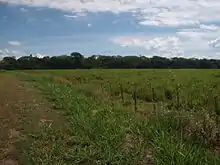Seasonal semideciduous forest
The seasonal semideciduous forest is a vegetation type that belongs to the Atlantic Forest biome (Inland Atlantic Forest), but is also found occasionally in the Cerrado.[1] Typical of central Brazil, it is caused by a double climatic seasonality: a season of intense summer rains followed by a period of drought. It is composed of phanerophytes with leaf buds that are protected from drought by scales (cataphylls or hairs), having deciduous sclerophyllous or membranaceous adult leaves. The degree of deciduousness, i.e. leaf loss, is dependent on the intensity and duration of basically two reasons: minimum and maximum temperatures and water balance deficiency. The percentage of deciduous trees in the forest as a whole is 20-50%.[2]

The vegetation is located in the north and west of Paraná, region of the third plateau, where it presents different types of soil. It is also widely distributed in the southern portion of Mato Grosso do Sul, interspersed between fields up to the 21st parallel, where it appears in riparian forests, being called alluvial seasonal semideciduous forest.[2]
Terminology
According to Rodrigues (1999), the seasonal semideciduous forest (IBGE, 1993) corresponds approximately to the following designations:[3][4]
- subtropical rain forest (Wettstein, 1904);[5]
- inland rain forests (Campos, 1912);[6]
- tropical semideciduous broadleaved forest (Kuhlmann, 1956);[7]
- tropical seasonal rain forest of the south-central plateau (Veloso, 1962);[8]
- mesophytic semideciduous forest (Rizzini, 1963);[9]
- sub-caducifolia or tropical seasonal forest (Andrade-Lima, 1966);[10]
- semideciduous plateau forest (Eiten, 1970);[11]
- subtropical foliated forests (Hueck, 1972);[12]
- submontane seasonal semideciduous forest (Veloso and Góes Filho, 1982);[13]
- semideciduous latifolia forest or plateau forest (Leitão Filho, 1982);[14]
- Mata de Cipó.[15]
Categories
There is an IBGE (2012) altimetric division to delimit study regions, which is:[2]
- alluvial seasonal semideciduous forest: most frequent in the Pantanal;
- lowland seasonal semideciduous forest: from Rio Grande do Norte to Rio de Janeiro, characterized by the African genus Caesalpinia, including the brazilwood tree;
- submontane seasonal semideciduous forest: from Espírito Santo to Paraná, entering the inland states, on the plateaus and in the Mantiqueira and Órgãos mountains;
- montane seasonal semideciduous forest: small area in Itatiaia and Roraima;
Some authors also indicate a fifth type, the coastal seasonal semideciduous forest (or Mata dos Tabuleiros), present along the east coast of Brazil, mainly between the states of Bahia and Rio de Janeiro.[16]
Flora
Main Amazonian genera of Brazilian origin are:[2]
Preservation



The Inland Atlantic Forest is one of the ecoregions of the Atlantic Forest that is in the worst state of conservation. The largest tract (about 471,204 km2) of seasonal semideciduous forest was part of the Alto Paraná Atlantic Forests (or Selva Paranaense) ecoregion. It extended from northwestern São Paulo to southeastern Paraguay and the Argentine province of Misiones. In Brazil, only 2.7% (about 7,716 km2) of the original vegetation cover remains, which can be found in Morro do Diabo State Park, Iguaçu National Park and Turvo State Park, its largest well-preserved tracts. Most of the remaining forest is located in the province of Misiones, with about 11,230 km2. In Paraguay, there are 11,523 km2, which represent only 13.5% of the original coverage.[17]
In Brazil, the situation is more critical. For a fragment to be considered large and to harbour significant species of the biome, such as large mammals (like the jaguar), it needs to be at least 10,000 hectares (100 km2). In the interior of São Paulo, the only fragment that has an area larger than this is the Morro do Diabo State Park. In the state of Rio Grande do Sul, this type of vegetation has been reduced by 4.26% (about 2,102.75 km2) of its original coverage.[18][17]
See also
References
- Pereira, Benedito Alísio da Silva; Venturoli, Fábio; Carvalho, Fabricio Alvim (2011). "FLORESTAS ESTACIONAIS NO CERRADO: UMA VISÃO GERAL". Pesq. Agropec. Trop. 41 (3): 446–455.
- Manual técnico da vegetação brasileira (PDF) (2 ed.). Rio de Janeiro: IBGE. 2012.
- Rodrigues, Ricardo Ribeiro (1999). A vegetação de Piracicaba e municípios do entorno (PDF) (189 ed.). IPEF.
- "Mapa de vegetação do Brasil". IBGE. 1992.
- Wettstein, Richard (1970). Aspectos da vegetação do sul do Brasil. E. Blücher.
- Campos, Gonzaga de (1912). Mappa florestal. Rio de Janeiro: Typ. da Directoria do Servio de Estatistica. doi:10.5962/bhl.title.4325.
- Kuhlmann, E (1956). "Os tipos de vegetação do Brasil: elementos para↵uma classificação fisionômica". Anais da Associação Geográfica do Brasil. 8 (1): 133–180.
- Veloso, H. P. (1962). Os grandes clímaces do Brasil: 1-considerações sobre os tipos vegetativos da região sul. Vol. 60 (1 ed.). Memórias do Instituto Oswaldo Cruz.
- Rizzini, C. T. "Nota prévia sobre a divisão fitogeográfica do Brasil" (PDF). Revista Brasileira de Geografia. 25 (1): 3–64.
- Andrade-Lima, D. Vegetação. Atlas nacional do Brasil.
- Eiten, G. "A vegetação do Estado de São Paulo". Boletim do Instituto de Botânica de São Paulo. 7 (1): 1–147.
- Hueck, Kurt (1972). As florestas da América do Sul: ecologia, composição e importância econômica. UNB.
- Veloso, Henrique P.; Goés Filho, Luiz (1982). Fitogeografia brasileira : classificação fisionômico - ecológica da vegetação neotropical. IBGE.
- Leitão Filho, H.F. (1982). "Aspectos taxonômicos das florestas do Estado de São Paulo". Silvicultura em São Paulo. 16 (1): 197–206.
- Soares Filho, Avaldo de Oliveira (2012). "Fitogeografia e estrutura das florestas estacionais deciduais no Brasi". UEFS.
- Silva, Guilherme C. da; Nascimento, Marcelo T. "Fitossociologia de um remanescente de mata sobre tabuleiros no norte do estado do Rio de Janeiro (Mata do Carvão)" (PDF). Revista brasil. Bot. 24 (1): 51–62.
- "A ECORREGIÃO FLORESTAS DO ALTO PARANÁ". Retrieved 2012-03-27.
- "RESULTADOS POR TIPO FITOGEOGRÁFICO". UFSM. Retrieved 2012-03-29.
Bibliography
- Ramos, V. S.; Franco, G. A. D. C.; Siqueira, M. F. (2008). Árvores da floresta estacional semidecidual: guia de identificação de espécies. EDUSP.